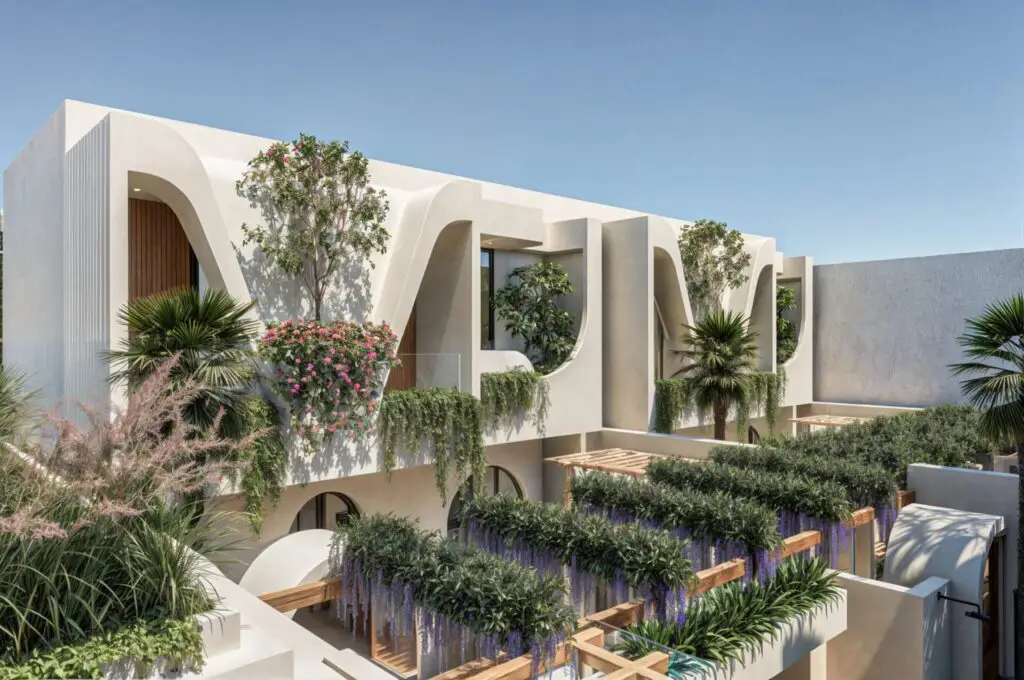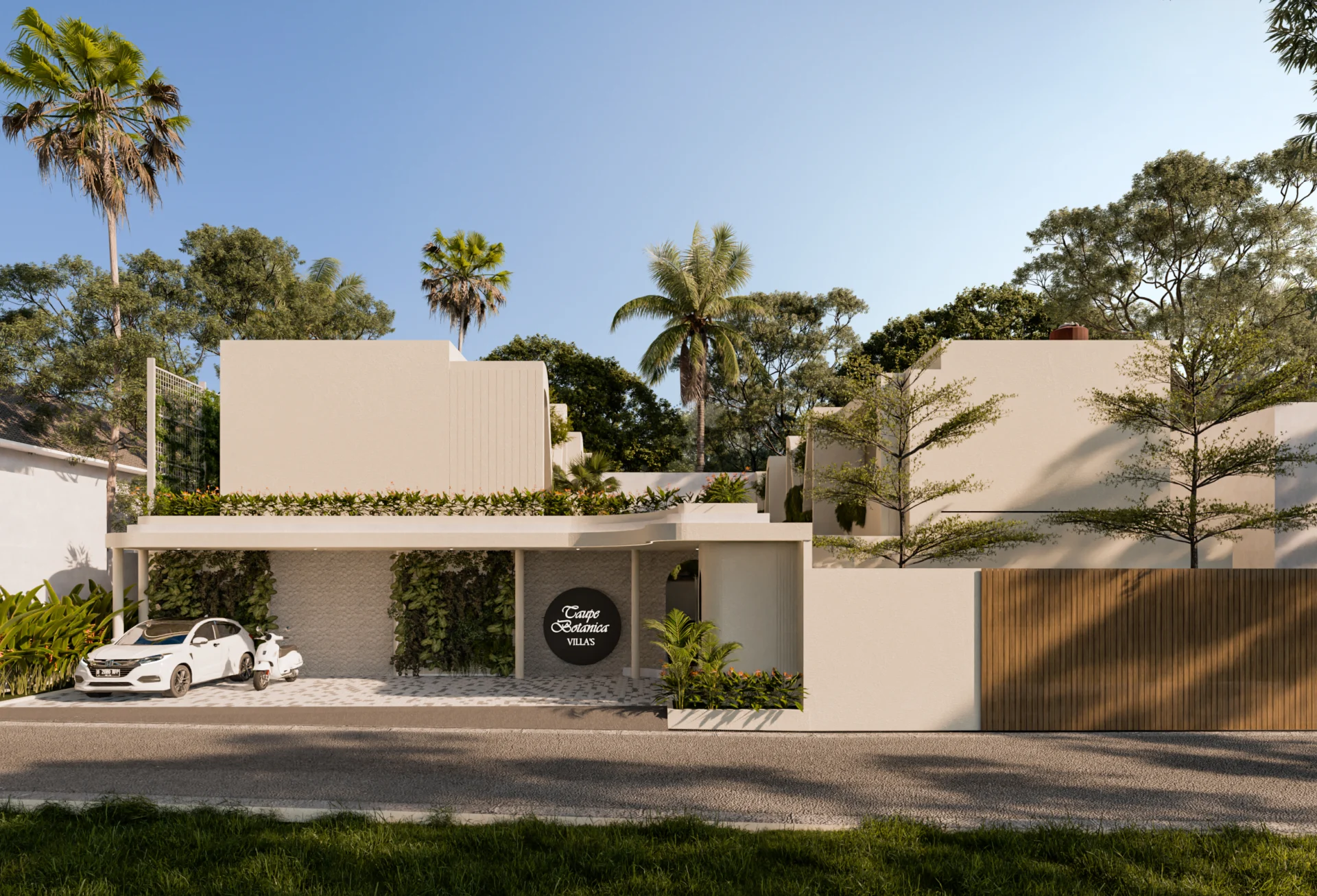
As we navigate the complexities of the climate crisis and urbanization, eco friendly building design has transitioned from a trend to a necessity.
In 2025, architects and developers around the world are increasingly adopting sustainable practices to create buildings that are not only energy-efficient but also harmonious with the environment.
Let’s explore how Manon brings a better world to life through eco friendly building design!
What Is Eco Friendly Building Design?
According to the Green Building Council Indonesia (GBCI), eco friendly building design is all about creating spaces that are environmentally responsible and resource-efficient throughout their entire life cycle; from planning and design to construction, operation, and even eventual renovation or demolition.
GBCI encourages sustainable practices that are tailored to Indonesia’s climate and context, aiming not only to reduce a building’s environmental impact but also to enhance the health and comfort of the people inside.
Their GREENSHIP certification evaluates buildings across key areas, such as:
- Energy efficiency
- Water conservation
- Materials
- Indoor air quality
- Site development
- Promoting healthier, more sustainable living and working spaces
Here is how it works in practice:
1. Sustainable Materials
Using renewable, recycled, or low-carbon materials can make a huge difference. Think plant fibers, natural stone, or certified wood.
A great example is Sweden’s Stockholm Wood City, planned to be the world’s largest city made entirely from timber, providing 2,000 new homes by 2027.
It is proof that sustainable choices can also be bold and innovative.
2. Energy Efficiency
Saving energy does not mean sacrificing comfort. Net-Zero Energy Buildings (NZEBs) produce as much energy as they use over a year, often thanks to solar panels and other renewable sources.
Smart building tech, like IoT sensors and AI systems, helps manage energy usage efficiently which keeps costs down and sustainability up.
3. Water Conservation
These strategies are easier than you might think! Installing efficient fixtures, harvesting rainwater, and using drought-tolerant plants can significantly reduce water use and utility bills. Because every drop counts when it comes to sustainable building design.
4. Indoor Environmental Quality
A building should feel as good as it looks. Using non-toxic materials, maximizing natural light, and ensuring proper ventilation all help create a healthy and comfortable space. Better air, better light, better well-being, it is that simple!
By weaving these principles together, eco friendly building design does not just cut carbon, but it creates spaces where people feel good, inspired, and connected to the environment.
It is sustainability with heart, and it is shaping the future of architecture in 2025 and beyond.
Also Read: Smart Green Building Design Principles
Key Trends in Eco Friendly Building Design for 2025

Sustainability in architecture is evolving fast, and 2025 brings some exciting trends that go beyond just “green.”
Here are the key directions shaping eco friendly building design you should know:
1. Regenerative Design
Going beyond sustainability, regenerative design aims to actively restore and enhance the environment.
Think green roofs that support local biodiversity or rainwater harvesting systems that replenish water tables. Your buildings are not just neutral, but they are also giving back.
Example
Ca’n Gallineta in Mallorca, Spain, designed by OAM, exemplifies regenerative design by integrating traditional Mallorcan architecture with sustainable practices.
The home utilizes local materials like lime mortar, site-sourced stone, and natural insulation from Neptune grass. It also incorporates cellular concrete walls for energy efficiency and minimal waste, blending seamlessly with its Mediterranean surroundings while promoting environmental restoration.
2. Smart Building Technologies
The rise of IoT devices and AI means buildings can now “think” for themselves. These smart systems monitor and optimize energy use in real time, such as:
- Adjusting lighting
- Heating
- Cooling based on occupancy and weather
The result? Major energy savings and a more comfortable space.
Example
Lombard Odier’s 1Roof headquarters in Geneva, Switzerland, showcases the integration of geothermal technology and smart building systems. The building employs the GeniLac system, utilizing the stable temperature of Lake Geneva’s deep waters for heating and cooling.
Coupled with smart architectural design elements like alpine wind alignment and rainwater collection, the building reduces the bank’s carbon footprint by 25% and is on track to qualify for top sustainability certifications.
3. Low-Carbon and Recycled Materials
Materials like bamboo, hempcrete, and recycled steel are gaining popularity, thanks to their low environmental impact.
Not only do they cut carbon emissions, but many are renewable, giving architects more ways to create sustainable, beautiful spaces.
4. Biophilic Design
Humans naturally thrive in connection with nature. Biophilic design incorporates elements like indoor plants, natural light, and water features to enhance mental well-being, productivity, and comfort, making buildings feel alive and welcoming.
Example
The Barbican Centre in London, UK, is one of the earliest and most famous examples of biophilic architecture.
Opened in the 1980s, it integrates natural and artificial lakes with extensive wildlife and houses over 1,500 species of plants and trees in its conservatory.
This design promotes a connection between occupants and nature, enhancing well-being and environmental quality.
Are you looking for biophilic inspiration in Indonesia? Manon is thrilled to share a project that brings natural elements right into the heart of the building. Check out here!
5. Net-Zero Energy Buildings
These buildings produce as much energy as they consume over the year, often using solar panels or wind turbines. Highly energy-efficient by design, these buildings are quickly becoming the standard in sustainable architecture.
Example
The Environmental Nature Center & Preschool in Newport Beach, California, designed by LPA Design Studios, is the first LEED Platinum building in the region.
It serves as an inspiring example of how sustainable design principles can be employed in educational facilities, aiming to produce as much energy as it consumes annually through renewable sources.
6. Occupant Well-Being
eco friendly buildings do not just focus on energy and materials, but they also prioritize the health and comfort of the people inside. Features like abundant natural light, proper ventilation, thermal comfort, and access to greenery support physical and mental well-being, making the space truly sustainable for everyone.
Example
The Khoo Teck Puat Hospital in Singapore integrates green spaces, natural ventilation, and daylight into patient rooms and communal areas. Beyond reducing energy use, the design enhances patient recovery, staff productivity, and overall occupant satisfaction, showing how eco-design can serve the planet and its people.
How Do Architects and Developers Implement Eco Friendly Building Design?

Bringing sustainability into your building projects does not have to be complicated. Here is how you can start:
1. Conduct Site Assessments
Get to know your site! Understanding the local climate, terrain, and surrounding ecosystem helps you make design decisions that are both practical and environmentally conscious.
2. Select Sustainable Materials
Opt for materials that are locally sourced, renewable, or have low embodied energy. Think bamboo, recycled steel, FSC-certified timber, lightweight bricks, low-VOC finishes or low-carbon concrete, these materials help reduce environmental impact without compromising quality.
3. Integrate Renewable Energy Systems
Solar panels, wind turbines, or geothermal systems can significantly reduce your reliance on fossil fuels while boosting your building’s energy efficiency.
Start integrating smart systems in your home, like sensors and building automation which helps optimize energy use, while small-scale renewable solutions such as solar water heaters or hybrid energy systems further enhance sustainability and comfort.
4. Optimize Water Use
Conserve water through rainwater harvesting, greywater recycling, and low-flow fixtures. Small changes can make a big difference in overall sustainability.
5. Design for Longevity
Create adaptable, flexible spaces that can evolve with future needs. This reduces the need for demolition and reconstruction, saving resources and minimizing waste.
Also Read: What Is Wellness Architecture in 2025?
FAQs About Eco Friendly Building Design
- What are the primary benefits of eco friendly building design?
Benefits include reduced energy and water consumption, lower operating costs, improved indoor air quality, and enhanced occupant health and productivity.
- How can I start implementing sustainable practices in my building projects?
Begin by conducting energy audits, selecting sustainable materials, and integrating renewable energy systems into your designs.
- Are eco friendly buildings more expensive to construct?
While initial costs may be higher, the long-term savings from reduced energy and maintenance costs often offset the investment.
Also Read: 3 Biophilic Design Apartment Ideas to Bring Nature In
Adopting eco friendly building design is no longer optional but essential for creating sustainable, resilient, and healthy built environments. By embracing the latest trends and technologies, everybody can contribute to a greener future while meeting the growing demand for sustainable living spaces.
If you are one of those people who are planning a project and wish to incorporate sustainable design principles, contact Manon Design Studio Bali for expert guidance and innovative solutions tailored to your needs.
***Note: The information provided in this article is based on the latest industry trends and practices as of 2025. For more detailed insights, refer to the sources cited above.
